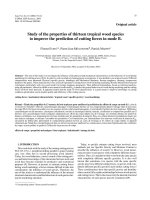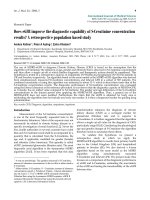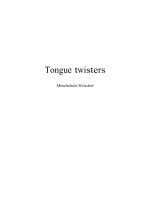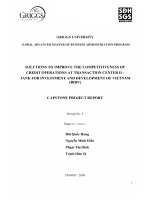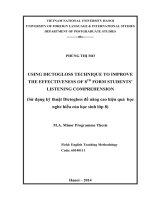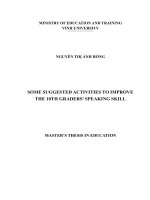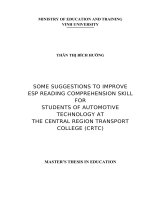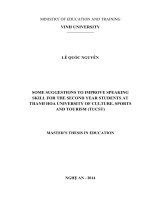Some Propositions to Improve the Prediction Capability of Word Confidence Estimation for Machine Translation
Bạn đang xem bản rút gọn của tài liệu. Xem và tải ngay bản đầy đủ của tài liệu tại đây (293.56 KB, 14 trang )
VNU Journal of Science: Comp. Science & Com. Eng. Vol. 30, No. 3 (2014) 36–49
Some Propositions to Improve the Prediction Capability of
Word Confidence Estimation for Machine Translation
Ngoc Quang Luong, Laurent Besacier, Benjamin Lecouteux
Laboratoire d’Informatique de Grenoble,
41, Rue des Math´ematiques, UJF - BP53, F-38041 Grenoble Cedex 9, France
Abstract
Word Confidence Estimation (WCE) is the task of predicting the correct and incorrect words in the MT output.test
Dealing with this problem, this paper proposes some ideas to build a binary estimator and then enhance its
prediction capability. We integrate a number of features of various types (system-based, lexical, syntactic and
semantic) into the conventional feature set, to build our classifier. After the experiment with all features, we
deploy a “Feature Selection” strategy to filter the best performing ones. Next, we propose a method that combines
multiple “weak” classifiers to build a strong “composite” classifier by taking advantage of their complementarity.
Experimental results show that our propositions helped to achieve a better performance in term of F-score. Finally,
we test whether WCE output can play any role in improving the sentence level confidence estimation system.
© 2014 Published by VNU Journal of Science.
Manuscript communication: received 15 December 2013, revised 04 April 2014, accepted 07 April 2014
Corresponding author: Luong Ngoc Quang,
Keywords: Machine Translation, Confidence Measure, Confidence Estimation, Conditional Random Fields,
Boosting
1. Introduction
Statistical Machine Translation (SMT)
systems in recent years have marked impressive
breakthroughs with numerous commendable
achievements, as they produced more and more
user-acceptable outputs. Nevertheless the users
still face with some open questions: are these
translations ready to be published as they are?
Are they worth to be corrected or do they require
retranslation? It is undoubtedly that building
a method which is capable of pointing out the
correct parts as well as detecting the translation
errors in each MT hypothesis is crucial to tackle
these above issues. If we limit the concept “parts”
to “words”, the problem is called Word-level
Confidence Estimation (WCE) [1].
The WCE’s objective is to judge each word
in the MT hypothesis as correct or incorrect by
tagging it with an appropriate label. A classifier
which has been trained beforehand calculates the
confidence score for the MT output word, and
then compares it with a pre-defined threshold. All
words with scores that exceed this threshold are
categorized in the Good label set; the rest belongs
to the Bad label set.
The contributions of WCE for the other
aspects of MT are incontestable. First, it
assists the post-editors to quickly identify the
translation errors [2], determine whether to
correct the sentence or retranslate it from scratch,
hence improve their productivity. Second, the
confidence score of words is a potential clue to
re-rank the SMT N-best lists [3, 2]. Last but not
least, WCE can also be used by the translators in
an interactive scenario [4].
This article integrates a number of our novel
features into the conventional feature set and
trains them by a conditional random fields (CRF)
N.Q. Luong et al. / VNU Journal of Science: Comp. Science & Com. Eng. Vol. 30, No. 3 (2014) 36–49 37
model to build a classifier for WCE. We then set
up a feature selection procedure, which identifies
the most useful indicators for the prediction.
Finally, we propose a method to improve
the WCE performance by taking advantage of
multiple sub-models’ complementarity. In the
next section, we review some previous researches
about confidence estimation. Section 3 details
the features used for the classifier construction.
Section 4 lists our settings to prepare for
the preliminary experiments and the baseline
experimental results are reported in Section
5. Section 6 explains our feature selection
procedure. Section 7 describes the Boosting
method to improve the system performance. The
integration of WCE into Sentence Confidence
Estimation (SCE) system is presented in Section
8. The last section concludes the paper and points
out some ongoing researches.
2. Related Work
To cope with WCE, various approaches have
been proposed, aiming at two major issues:
features and Machine Learning (ML) model to
build the classifier. In this review, we refer
mainly to two general types of features: internal
and external features. “Internal features” (or
“system-based features”) are extracted from the
components of MT system itself, generated
before or during translation process (N-best lists,
word graph, alignment table, language model,
etc.). “External features” are constructed thanks
to external linguistic knowledge sources and
tools, such as Part-Of-Speech (POS) Tagger,
syntactic parser, WordNet, stop word list, etc.
The authors in [5] combine a considerable
number of features by applying neural network
and naive Bayes learning algorithms. Among
these features, Word Posterior Probability
(henceforth WPP) proposed by [6] is shown to
be the most effective system-based features. The
combination of WPP (with 3 different variants)
and IBM-Model 1 features is also shown to
overwhelm all the other single ones, including
heuristic and semantic features [7]. Using solely
N-best list, the authors in [8] suggest 9 different
features and then adopt a smoothed naive Bayes
classification model to train the classifier.
Another study [1] introduces a novel approach
that explicitly explores the phrase-based
translation model for detecting word errors.
A phrase is considered as a contiguous sequence
of words and is extracted from the word-aligned
bilingual training corpus. The confidence
value of each target word is then computed by
summing over all phrase pairs in which the target
part contains this word. Experimental results
indicate that the method yields an impressive
reduction of the classification error rate compared
to the state-of-the-art on the same language pairs.
In [9], the classifier is built by integrating
the POS of the target word with another
lexical feature named “Null Dependency Link”
and training them by Maximum Entropy
model. Interestingly, linguistic features sharply
outperform WPP feature in terms of F-score and
classification error rate.
Unlike most of previous work, the authors in
[10] apply solely external features with the hope
that their classifier can deal with various MT
approaches, from statistical-based to rule-based.
Given a MT output, the BLEU score is predicted
by their regression model. Results show that their
system maintains consistent performance across
various language pairs.
A method to calculate the confidence score
for both words and sentences relied on a
feature-rich classifier is proposed by [2]. The
novel features employed include source side
information, alignment context, and dependency
structure. Their integration helps to augment
marginally in F-score as well as the Pearson
correlation with human judgment. Moreover,
their CE scores assist MT system to re-rank
the N-best lists which improves considerably
translation quality.
A recent study [11] applies 70 linguistic
features guided by three main aspects of
translation: accuracy, fluency and coherence to
investigate their usefulness. Unfortunately these
features were not yet able to beat shallower
features based on statistics from the input text,
its translation and additional corpora. Results
38 N.Q. Luong et al. / VNU Journal of Science: Comp. Science & Com. Eng. Vol. 30, No. 3 (2014) 36–49
reveal that linguistic features are still helpful, but
need to be carefully integrated to reach better
performance.
In the submitted system to the WMT12
shared task on Quality Estimation, the authors
in [12] add some new features to the baseline
provided by the organizers, including averaged,
intra-lingual, basic parser and out-of-vocabulary
features. They are then trained by SVM
model, then filtered by forward-backward feature
selection algorithm. This algorithm waives
features which linearly correlated with others
while keeping those relevant for prediction. It
increases slightly the performance of all-feature
system in terms of Root Mean Square Error
(RMSE).
Aiming at an MT system-independent quality
assessment, “referential translation machines”
(RTM) method proposed in [13] shows its
prediction performance in WMT 2013, without
accessing any SMT system specific resource and
prior knowledge used to train data or model.
RTM takes into account the acts of translation
when translating between two data sets with
respect to a reference corpus in the same domain.
Our work differs from previous researches at
these main points: firstly, we integrate various
types of prediction indicators: system-based
features extracted from the MT system (N-best
lists with the score of the log-linear model,
source and target language model etc.), together
with lexical, syntactic and semantic features to
see if this combination improves the baselines
performance [14]. Different from our previous
work [14], this time we apply multiple ML
models to train this feature set and then compare
the performance to select the optimal one among
them. Secondly, the usefulness of all features
is deeper investigated in detail using a greedy
feature selection algorithm. Thirdly, we propose
a solution which exploits Boosting algorithm as
a learning method in order to strengthen the
contribution of dominant feature subsets to the
system, thus improve of the system’s prediction
capability. Lastly, we explore the contribution
of WCE in enhancing the quality estimation
at sentence level. All these initiatives will
be consequentially introduced, starting by the
feature set building.
3. Features
This section depicts in details 25 features
exploited to train our classifier. Among them,
those marked with a symbol are proposed by
us, and the remaining comes from the previous
work. Interestingly, these features have been used
in our English - Spanish WCE system which got
the first rank in WMT 2013 Quality Estimation
shared task (Task 2) [15].
3.1. System-based Features
They are the features extracted directly
from our baseline SMT system, without
the participation of any additional external
component. Based on the resources where
features are found, they can be sub-categorized
as following:
3.1.1. Target Side Features
We take into account the information of every
word (at position i in the MT output), including:
• The word itself
• The sequences formed between it and a word
before (i − 1/i) or after it (i/i + 1)
• The trigram sequences formed by it and
two previous and two following words
(including: i − 2/i − 1/i; i − 1/i/i + 1;
i/i + 1/i + 2)
• The number of occurrences in the sentence
3.1.2. Source Side Features
Using the alignment information, we can track
the source words which the target word is aligned
to. To facilitate the alignment representation,
we apply the BIO
1
format: in case of multiple
target words are aligned with one source word,
the first word’s alignment information will be
prefixed with symbol “B-” (means “Begin”);
1
/>N.Q. Luong et al. / VNU Journal of Science: Comp. Science & Com. Eng. Vol. 30, No. 3 (2014) 36–49 39
Table 1. Example of using BIO format to represent the alignment information
Target words
(MT output)
Source aligned
words
Target words
(MT output)
Source aligned
words
The B-le to B-de
public B-public look B-tourner
will B-aura again B-
`
a|nouveau
soon B-bient
ˆ
ot at B-son
have I-aura its I-son
the B-l’ attention B-attention
opportunity B-occasion . B
and “I-” (means “Inside”) will be added at the
beginning of alignment information for each of
the remaining ones. The target words which
are not aligned with any source word will be
represented as “O” (means “Outside”). Table 1
shows an example for this representation, in
case of the hypothesis is “The public will
soon have the opportunity to look again at its
attention.”, given its source: “Le public aura
bientˆot l’occasion de tourner `a nouveau son
attention.”. Since two target words “will” and
“have” are aligned to “aura” in the source
sentence, the alignment information for them will
be “B-aura” and “I-aura” respectively. In case
a target word has multiple aligned source words
(such as “again”), we separate these words by
the symbol “|” after putting the prefix “B-” at the
beginning.
3.1.3. Alignment Context Features
These features are proposed by [2] in regard
with the intuition that collocation is a believable
indicator for judging if a target word is generated
by a particular source word. We also apply them
in our experiments, containing:
• Source alignment context features: the
combinations of the target word and one
word before (left source context) or after
(right source context) the source word
aligned to it.
• Target alignment context features: the
combinations of the source word and each
word in the window ±2 (two before, two
after) of the target word.
For instance, in case of “opportunity” in
Table 1, the source alignment context features
are: “opportunity/l”’ and “opportunity/de”;
while the target alignment context features
are: “occasion/have”, “occasion/the”,
“occasion/opportunity”, “occasion/to”,
“occasion/look”.
3.1.4. Word Posterior Probability
WPP [6] is the likelihood of the word
occurring in the target sentence, given the source
sentence. Numerous knowledge sources have
been proposed to calculate it, such as word
graphs, N-best lists, statistical word or phrase
lexical. To calculate it, the key point is to
determine sentences in N-best lists that contain
the word e under consideration in a fixed position
i . Let p( f
J
1
, e
I
1
) be the joint probability of
source sentence f
J
1
and target sentence e
I
1
. The
WPP of e occurring in position i is computed
by aggregating probabilities of all sentences
containing e in this position:
p
i
(e| f
J
1
) =
p
i
(e, f
J
1
)
e
p
i
(e
, f
J
1
)
(1)
where
p
i
(e, f
J
1
) =
I,e
I
1
Θ(e
i
, e) · p( f
J
1
, e
I
1
) (2)
Here Θ(., .) is the Kronecker function. The
normalization in equation (1) is:
e
p
i
(e
, f
J
1
) =
I,e
I
1
p( f
J
1
, e
I
1
) = p( f
J
1
) (3)
40 N.Q. Luong et al. / VNU Journal of Science: Comp. Science & Com. Eng. Vol. 30, No. 3 (2014) 36–49
In this work, we exploit the graph that represents
MT hypotheses [16]. From this, the WPP of
word e in position i (denoted by WPP exact) can
be calculated by summing up the probabilities of
all paths containing an edge annotated with e in
position i of the target sentence. Another form
is “WPP any” in case we ignore the position i,
or in other words, we sum up the probabilities
of all paths containing an edge annotated with
e in any position of the target sentence. Here,
both forms are used and the above summation
is performed by applying the forward-backward
algorithm [17].
3.1.5. Graph topology features
They are based on the N-best list graph merged
into a confusion network. On this network,
each word in the hypothesis is labeled with its
WPP, and belongs to one confusion set. Every
completed path passing through all nodes in the
network represents one sentence in the N-best,
and must contain exactly one link from each
confusion set. Looking into a confusion set
(which the hypothesis word belongs to), we
find some information that can be the useful
indicators, including: the number of alternative
paths it contains (called Nodes) , and the
distribution of posterior probabilities tracked over
all its words (most interesting are maximum and
minimum probabilities, called Max and Min)
. We assign three above numbers as features for
the hypothesis word.
3.1.6. Language Model Based Features
Applying SRILM toolkit [18] with the
bilingual corpus, we build 4-gram language
models for both target and source side. These
language models permit to compute the “longest
target n-gram length” and “longest source
n-gram length” (length of the longest sequence
created by the current token and its previous
ones in the target or source language model) of
each word in MT output as well as in the source
sentence. For example, with the target current
token w
i
: if the sequence w
i−2
w
i−1
w
i
appears
in the target language model but the sequence
w
i−3
w
i−2
w
i−1
w
i
does not, the n-gram value for
w
i
will be 3. The value set for each word hence
ranges from 0 to 4. Similarly, we compute the
same value for the source word aligned to w
i
in
the source language model, and use both of them
as features.
Additionally, we employ another feature
named the backoff behavior [19] of the backward
3-gram target language model to investigate
more deeply the role of two previous words by
considering various cases of their occurrences,
from which a score is given to each word w
i
, as
below:
B(w
i
) =
7 if w
i−2
, w
i−1
, w
i
exists
6 if w
i−2
, w
i−1
and w
i−1
, w
i
both exist
5 if only w
i−1
, w
i
exists
4 if w
i−2
, w
i−1
and w
i
exist separately
3 if w
i−1
and w
i
both exist
2 if only w
i
exists
1 if w
i
is out of vocabulary
(4)
(The concept “exist” here means “appear in the
language model”).
3.2. Lexical Features
A prominent lexical feature that has been
widely explored in WCE researches is word’s
Part-Of-Speech (POS). This tag is assigned to
each word due to its syntactic and morphological
behaviors to indicate its lexical category. We use
TreeTagger
2
toolkit for POS annotation task and
obtain the following features for each target word:
• Its POS
• Sequence of POS of all source words aligned
to it (in BIO format)
• Bigram and trigram sequences between its
POS and the POS of previous and following
words. Bigram sequences are POS
i−1
, POS
i
and POS
i
, POS
i+1
and trigram sequences are:
POS
i−2
, POS
i−1
, POS
i
; POS
i−1
, POS
i
, POS
i+1
and POS
i
, POS
i+1
, POS
i+2
2
/>TreeTagger/
N.Q. Luong et al. / VNU Journal of Science: Comp. Science & Com. Eng. Vol. 30, No. 3 (2014) 36–49 41
Fig. 1. Example of parsing result generated by Link Grammar
In addition, we also build four other binary
features that indicate whether the word is a: stop
word (based on the stop word list for target
language), punctuation symbol, proper name or
numerical.
3.3. Syntactic Features
Besides lexical features, the syntactic
information about a word is also a potential
hint for predicting its correctness. If a word has
grammatical relations with the others, it will
be more likely to be correct than those which
has no relation. In order to obtain the links
between words, we select the Link Grammar
Parser
3
as our syntactic parser, affording us to
build a syntactic structure for each sentence in
which each pair of grammar-related words is
connected by a labeled link. In case of Link
Grammar fails to find the full linkage for the
whole sentence, it will skip each word one time
until the sub-linkage for the remaining words has
been successfully built. Based on this structure,
we get the “Null Link” [9] characteristic of
the word. This feature is binary: 0 in case of
word has at least one link with the others, and
1 if otherwise. Another benefit yielded by this
parser is the “constituent” tree (Penn tree-bank
style phrase tree) representing the sentence’s
grammatical structure (showing noun phrases,
verb phrases, etc.). This tree helps to produce
more word syntactic features, including its
constituent label and its depth in the tree (or
the distance between it and the tree root).
It is intuitive to observe that the words in
brackets (including “until” and “mid”) have no
link with the others, meanwhile the remaining
ones have. For instance, the word “trying” is
connected with “to” by the link “TO” and with
3
/>“been” by the link “Pg*b”. Hence, the value of
“Null Link” feature for “mid” is 1 and for “trying”
is 0. The figure also brings us the constituent label
and the distance to the root of each word. In case
of the word “government”, these values are “NP”
and “2”, respectively.
3.4. Semantic Features
We study the semantic characteristic of word
by taking into account its polysemy. We hope that
the number of senses of each target word given its
POS can be a reliable indicator for judging if it is
the translation of a particular source word. The
feature “Polysemy count” is built by applying a
Perl extension named Lingua::WordNet
4
, which
provides functions for manipulating WordNet
5
database.
4. Experimental Settings
4.1. Our French - English SMT System
Our French - English SMT system is
constructed using the Moses toolkit [20],
which contains all of necessary components
to train the translation model. We keep the
Moses’s default setting: log-linear model with
14 weighted feature functions. The translation
model is trained on the Europarl and News
parallel corpora used for WMT
6
evaluation
campaign in 2010 (total 1,638,440 sentences).
Our target language model is a standard n-gram
language model trained using the SRI language
modeling toolkit [18] on the news monolingual
corpus (48,653,884 sentences). More details on
this baseline system can be referred in [21].
4
/>5
/>6
/>42 N.Q. Luong et al. / VNU Journal of Science: Comp. Science & Com. Eng. Vol. 30, No. 3 (2014) 36–49
Table 2. Example of training label obtained using TERp-A.
4.2. Corpus Preparation
We use our SMT system to generate the
translation hypothesis for 10,881 source
sentences taken from news corpora of the
WMT evaluation campaign (from 2006 to 2010).
A post-edition task was implemented by using
a crowdsourcing platform: Amazon Mechanical
Turk (MTurk), which allows a requester to
propose a paid or unpaid work and a worker to
perform the proposed task. To avoid the gap
between hypothesis and its post-edition since
the correctors can paraphrase or reorder words
to form the smoother translation, we highly
recommend them to keep the number of edit
operations as low as possible, but still ensure
the accuracy of the translation. A sub-set (311
sentences) of these collected post-editions is then
assessed by a professional translator. Testing
result shows that 87.1% of post-editions improve
the hypothesis. Detailed description for the
corpus construction can be found in [22]. We
extract 10,000 triples (source, hypothesis and
post edition) to form the training set, and keep
the remaining 881 triples for the test set.
4.3. Word Label Setting Using TERp-A
This task is performed by TERp-A toolkit
[23]. As an extension of TER, TERp-A
helps to eliminate its shortcomings by taking
into account the linguistic edit operations,
such as Stem matches, Synonyms matches
and Phrase Substitutions besides the TER’s
conventional ones (Exact match, Insertion,
Deletion, Substitution and Shift). These additions
allow us to avoid categorizing the hypothesis
word as Insertion or Substitution in case it shares
same stem, or belongs to the same synonym
set on WordNet, or is the phrasal substitution
of word(s) in the reference. In TERp-A, each
above-mentioned edit cost has been tuned to
maximize the correlation with human judgment
of Adequacy at the segment level. Table 2
illustrates the labels generated by TERp-A for
one hypothesis and reference pair. Each word
or phrase in the hypothesis is aligned to a
word or phrase in the reference with discrepant
types of edit: I (insertions), S (substitutions), T
(stem matches), Y (synonym matches), and P
(phrasal substitutions). The lack of a symbol
indicates an exact match and will be replaced by
E thereafter. We do not consider words marked
with D (deletions) since they appear only in the
reference. Then, to train a binary classifier, we
re-categorize the obtained 6-label set into binary
set: The E, T and Y are regrouped into the Good
(G) category, whereas the S, P and I belong to the
Bad (B) category. Finally, we observed that out
of total words (train and test sets) are 85% labeled
G, 15% labeled B.
4.4. Classifier Model Selection
In order to build the classifier, we train our
features by several conventional models, such
as: Decision Tree [24], Logistic Regression [25]
and Naive Bayes [26] using KNIME platform
7
.
However, since our intention is to treat WCE
as a sequence labeling task, we employ also
the CRF model [27]. Among CRF based
toolkits, we selected WAPITI [28] to train our
classifier. The training phase was conducted with
Stochastic Gradient Descent (SGD) algorithm
for L1-regularized model, which works by
computing the gradient only on a single sequence
at a time and making a small step in this
direction, therefore it can quickly reach an
acceptable solution for the model. In the training
command, we set values for the maximum
number of iterations (-maxiter), the stop window
size (–stopwin) and the stop epsilon (–stopeps)
to 200, 6 and 0.00005 respectively. We also
7
/>N.Q. Luong et al. / VNU Journal of Science: Comp. Science & Com. Eng. Vol. 30, No. 3 (2014) 36–49 43
compare our classifier with two naive baselines:
in baseline 1, all words in each MT hypothesis are
classified into G label. In baseline 2, we assigned
them randomly into G or B with respect to
the percentage between both labels in the corpus
(85% G, 15% B).
5. Baseline WCE Experiments
We evaluate the performance of our classifiers
by using common evaluation metrics: Precision
(Pr), Recall (Rc) and F-score (F). Suppose that
we would like to calculate these values for label
B. Let X be the number of words whose true
label is B and have been tagged with this label
by the classifier, Y is the total number of words
classified as B, and Z is the total number of words
which true label is B. From these concepts, Pr,
Rc and F can be defined as follows:
Pr =
X
Y
; Rc =
X
Z
; F =
2 × Pr × Rc
Pr + Rc
(5)
These calculations can be applied in the same
way for G label.
We perform our preliminary experiment by
training a CRF classifier with the combination
of all 25 features. The training algorithm and
related parameters were discussed in Section 4.4.
The classification task is then conducted multiple
times, corresponding to a threshold increase from
0.300 to 0.975 (step = 0.025). When threshold =
α, all words in the test set which the probability
for G class exceeds α will be labeled as “G”, and
the remaining will be labeled as “B”. The values
of Pr and Rc for G and B label are tracked along
this threshold variation. The results observed
show that in case of B label, Rc increases
gradually from 0.285 to 0.492 whereas Pr falls
from 0.438 to 0.353. With G label, the variation
occurs in the opposite direction: Rc drops almost
regularly from 0.919 to 0.799, meanwhile Pr
augments slightly from 0.851 to 0.876.
Table 3 reports the average values of Precision,
Recall and F-score of these labels in the
all-feature system and the baseline systems
(correspond to the above threshold variation).
Table 3. Average Precision, Recall and F-score for labels of
all-feature system and two baselines.
Fig. 2. Performance comparison (F
∗
) among different
classifiers
These values imply that in our system: (1) Good
label is much better predicted than Bad label, (2)
The combination of features helped to detect the
translation errors significantly above the “naive”
baselines.
In an attempt of investigating the performance
of CRF model, we compare it with several
other models, including: Decision Tree, Logistic
Regression and Naive Bayes. These three
classifiers are trained in the same condition
(features, training set) of our CRF one, and then
are used to test our usual test set. The pivotal
problem is how to define an appropriate metric
to compare them efficiently? Due to the fact that
in our training corpus, the number of G words
sharply beats the B ones, so it is fair to say that
with our classifiers, detecting a translation error
should be more appreciated than identifying a
good translated word. Therefore, we propose a
“composite” score called F
∗
putting more weight
on the capability of each system in detecting
translation error (represented by F-score for B
44 N.Q. Luong et al. / VNU Journal of Science: Comp. Science & Com. Eng. Vol. 30, No. 3 (2014) 36–49
label). Specifically, this value can be written by:
F
∗
= 0.70 ∗ F score(B) + 0.30 ∗ F score(G). We
track all scores along to the threshold variation
and then plot them in Figure 2. The topmost
position of CRF curve shown in the figure reveals
that the CRF model performs better than all the
remaining ones, and it is more suitable to deal
with our features and corpus. Another notable
observation is that the “optimal” threshold (which
gives the best F
∗
) for each classifier is different
from the others: 0.975 for CRF, 0.925 for
Decision Tree, 0.800 for Logistic Regression and
0.300 for Naive Bayes classifier. In the next
sections, which propose ideas to improve the
prediction capability, we work only with the CRF
classifier.
6. Feature Selection for WCE
In the previous section, the participation of
all 25 features yielded promising F scores for
G label, but not very convincing F scores for
B label. That can be originated from the risk
that not all of features are really useful, or in
other words, some are poor predictors and might
be the obstacles weakening the others combined
with them. In order to prevent this drawback,
we propose a method to filter the best features
based on the “Sequential Backward Selection”
algorithm
8
. We start from the full set of N
features, and in each step sequentially remove
the most useless one. To do that, all subsets
of (N-1) features are considered and the subset
that leads to the best performance gives us the
weakest feature (not included in the considered
set). This procedure is also called “leave one
out” in the literature. Obviously, the discarded
feature is not considered in the following steps.
We iterate the process until there is only one
remaining feature in the set, and use the following
score for comparing systems: F
avg
(all) = 0.30 ∗
F
avg
(G) + 0.70 ∗ F
avg
(B), where F
avg
(G) and
F
avg
(B) are the averaged F scores for G and B
label, respectively, when threshold varies from
0.300 to 0.975. This strategy enables us to sort
8
l11.pdf
the features in descending order of importance,
as displayed in Table 4. In this table, the letter
following each feature’s ranking represents its
category: “S” for system-based , “L” for lexical,
“T” for syntactic, and “M” for semantic feature;
and the symbol “*” (if possible) indicates that this
is a our proposed feature. Figure 3 shows the
evolution of the WCE performance as more and
more features are removed; along with the details
of 3 best-performing feature subsets yielding the
highest F-scores.
Fig. 3. Evolution of system performance (F
avg
(all)) during
Feature Selection process
Table 4 reveals that in our system,
system-based and lexical features seemingly
outperform the other types in terms of usefulness,
since in top 10, they contribute 8 (5 system-based
+ 3 lexical). However, 2 out of 3 syntactic
features appear in top 10, indicating that
their role cannot be disdained. It is hard to
conclude about the contribution of semantic
feature because so far we have exploited only
1 representative and it ranks 15. Observation
in 10-best and 10-worst performing features
suggests that features belonging to word origin
(word itself, POS) perform very well, meanwhile
those from word statistical knowledge sources
(target and source language models) are likely
to be much less beneficial. More remarkable,
we acknowledge the features which perform
efficiently (appear in Top 10) both current system
and in our English - Spanish one [15], including:
Source POS, Target Word, WPP (any), Target
N.Q. Luong et al. / VNU Journal of Science: Comp. Science & Com. Eng. Vol. 30, No. 3 (2014) 36–49 45
Table 4. The rank of each feature (in term of usefulness) in the set
Rank Feature name Rank Feature name
1L Source POS 14L Punctuation
2S Source word 15M
*
Polysemy count
3S Target word 16S
*
Longest source gram length
4S Backoff behavior 17S Number of occurrences
5S WPP any 18L Numeric
6L Target POS 19L Proper name
7T
*
Constituent label 20S Left target context
8S Left source context 21S
*
Min
9T Null link 22S
*
Longest target gram length
10L Stop word 23S Right source context
11S
*
Max 24T
*
Distance to root
12S Right target context 25S WPP exact
13S
*
Nodes
POS, and Left source alignment context. On the
contrary, “Left target alignment context” and
“Longest target gram length” perform poorly
in both systems as they belong to top 5 at the
bottom of the lists.
In addition, in Figure 3, when the size of
feature set is small (from 1 to 7), we can observe
sharply the growth of system scores for both
labels. Nevertheless the scores seem to saturate
as the feature set increases from the 8 up to 25.
This phenomenon raises a hypothesis about the
learning capability of our classifier when coping
with a large number of features, hence drives us
to an idea for improving the classification scores.
This idea is detailed in the next section.
7. Classifier Performance Improvement Using
Boosting
As stated before, the best performance did not
come from the “all-feature” system, but from
the system trained by a subset of 17 features.
Besides this, we could not find any considerable
progression in F-score when the feature set is
lengthened from 8 to 25. These observations
lead to a question: If we build a number of
“weak” (or “basic”) classifiers by using subsets
of our features, then train this classifier set by
a machine learning algorithm (such as Boosting
[29]), should we get a single “strong” classifier?
If deploying this idea, our hope is that multiple
models can complement each other as one feature
set might be specialized in a part of the data where
the others do not perform very well.
First, we prepare 23 sub feature sets
(F
1
, F
2
, , F
23
) to train 23 basic classifiers,
in which:
• F
1
contains all features,
• F
2
contains 17 top-ranked in Table 4, and
• F
i
(i = 3 23) contains 9 randomly chosen
features.
Next, the 10-fold cross validation is applied on
our usual 10K training set. We divide it into
10 equal subsets (S
1
, S
2
, . . . , S
10
). In the loop
i (i = 1 10), S
i
is used as the test set and the
remaining data is trained with 23 sub feature
sets. After each loop, we obtain the results from
23 classifiers for each word in S
i
. Finally, the
concatenation of these results after 10 loops gives
us the training data for Boosting. Therefore,
the Boosting training file has 23 columns, each
represents the output of one basic classifier for
our CRF training set. The detail of this algorithm
is described below:
Algorithm to build Boosting training data
for i :=1 to 10 do
begin
46 N.Q. Luong et al. / VNU Journal of Science: Comp. Science & Com. Eng. Vol. 30, No. 3 (2014) 36–49
TrainSet(i) := ∩S
j
( j = 1 10, j i)
TestSet(i) := S
i
for j := 1 to 23 do
begin
Classifier C
j
:= Train TrainSet(i) with F
j
Result R
j
:= Use C
j
to test S
i
Column P
j
:= Extract the “probability of word
to be G label” in R
j
end
Subset D
i
(23 columns) := {P
j
} ( j = 1 23)
end
Boosting training set D := ∩D
i
(i = 1 10)
Next, Bonzaiboost toolkit
9
(that is able to learn
from decision trees and apply Boosting algorithm
on them) is used for building Boosting model. In
the training command, following parameters are
invoked: algorithm = “AdaBoost”, depth of the
weak tree = 2, number of iterations = 300.
Meanwhile, the Boosting test set is prepared
as follows: we train 23 feature sets with the usual
10K training set to obtain 23 classifiers, then use
them to test the CRF test set, finally extract the
23 probability columns (like in the above pseudo
code). In the testing phase, similar to what we
did in Section 5, the averaged Pr, Rc and F scores
against threshold variation for G and B labels are
tracked as seen in Table 5. The distribution of F
scores in both labels, compared to CRF system,
is represented in Figure 4.
Fig. 4. Performance comparison between CRF and Boosting
systems.
9
/>The scores suggest that using Boosting
algorithm on our CRF classifiers’ output is an
efficient way to make them predict better: on
the one side, we maintain the already good
achievement on G class (only 0.05% lost), on the
other side we augment 2.89% the performance
in B class. It is likely that Boosting enables
discrepant models to better complement one
another, in terms of the later model becomes
experts for instances handled wrongly by the
previous ones. Another reason that yields the
better score is that Boosting algorithm weights
each model by its performance (rather than
treating them equally), so the strong models
(come from all features, top 17, etc.) can make
more dominant impacts than the others. The
results also show that all our features are helpful
if they are carefully and skilfuly integrated.
8. Using WCE in Sentence Confidence
Estimation (SCE)
WCE helps not only in detecting translation
errors, but also in improving the sentence level
prediction when combined with other sentence
features. To verify this, firstly we build a SCE
system (called SYS1) based on our WCE outputs
(prediction labels). The seven features used to
train SYS1 are:
• The ratio of number of good words to total
number of words. (1 feature)
• The ratio of number of good nouns to total
number of nouns. The similar ones are also
computed for other POS: verb, adjective and
adverb. (4 features)
• The ratio of number of n consecutive
good word sequences to total number of
consecutive word sequences. Here, n=2 and
n=3 are applied. (2 features)
Then, we inherit the script used in WMT12
10
for extracting 17 sentence features, to build an
10
/>baseline system
N.Q. Luong et al. / VNU Journal of Science: Comp. Science & Com. Eng. Vol. 30, No. 3 (2014) 36–49 47
Table 5. Comparison of the average Pr, Rc and F between CRF and Boosting systems
System Pr(G) Rc(G) F(G) Pr(B) Rc(B) F(B)
Boosting 90.10 84.13 87.02 34.33 49.83 40.65
CRF (all) 85.99 88.18 87.07 40.48 35.39 37.76
another SCE system (SYS2). In both SYS1
and SYS2, each sentence’s training label is an
integer score from 1 to 5, based on its TER score
[23] (when matching against the post-edition), as
following:
score(s) =
5 i f T ER(s) ≤ 0.1
4 i f 0.1 ≤ T ER(s) ≤ 0.3
3 i f 0.3 < T ER(s) ≤ 0.5
2 i f 0.5 < T ER(s) ≤ 0.7
1 i f T ER(s) > 0.7
(6)
Two conventional metrics are used to measure
the SCE system’s performance: Mean Absolute
Error (MAE) and Root of Mean Square Error
(RMSE)
11
. Given a test set S = s
1
, s
2
, , s
|S |
,
let R(s
i
) and H(s
i
) be the reference score
(determined by TERPA) and hypothesis score
(by our SCE system) for sentence s
i
respectively.
Then, MAE and RMSE can be formally defined
by:
MAE =
|S |
i=1
|R(s
i
) − H(s
i
)|
|S |
(7)
RMS E =
|S |
i=1
(|R(s
i
) − H(s
i
)|)
2
|S |
(8)
To observe the impact of WCE on SCE, we
design a third system (called SYS1+SYS2),
which takes the results yielded by SYS1 and
SYS2, post-processes them and makes the
final decision. For each sentence, SYS1 and
SYS2 generate five probabilities for five integer
labels it can be assigned, then select the label
which highest probability as the official result.
Meanwhile, SYS1+SYS2 collects probabilities
come from both systems, then updates the
probability for each label by the sum of two
11
/>mean-absolute-error-mae-and-mean-square-error-mse/
appropriate values in SYS1 and SYS2. Similarly,
the label with highest likelihood is assigned to
this sentence. The results obtained on the usual
test set are shown in Table 6.
Table 6. Scores of 3 different SCE systems.
Scores observed reveal that when WMT12
baseline features and those based on our WCE
are separately exploited, they yield acceptable
performance. More interesting, the contribution
of WCE is definitively proven when it is
combined with a SCE system: The combination
system SYS1+SYS2 sharply reduces MAE and
RMSE of both single systems. It demonstrates
that in order to judge effectively a sentence’s
overall quality, besides global and general
indicators, the information synthesized from the
quality of each word is also very useful.
9. Conclusions and Perspectives
We proposed some ideas to deal with WCE
for MT, starting with the integration of our
proposed features into the existing features to
build the classifier. The first experiment’s results
show that precision and recall obtained in G
label are very promising, and B label reaches
acceptable performance. A feature selection
strategy is then deployed to identify the valuable
features, find out the best performing subset. One
more contribution we made is the protocol of
applying Boosting algorithm, training multiple
“weak” classifiers, taking advantage of their
complementarity to get a “stronger” one. All
48 N.Q. Luong et al. / VNU Journal of Science: Comp. Science & Com. Eng. Vol. 30, No. 3 (2014) 36–49
of these above propositions aim at enhancing
the prediction capability for WCE. Finally, an
investigation about the help of WCE in lifting
up SCE system performance accentuates its
increasing vital role in MT sectors.
In the future, this work can be extended
in the following ways. Firstly, we take a
deeper look into linguistic features of word,
such as the grammar checker, dependency
tree, semantic similarity, etc. Besides, we
would like to investigate the segment-level
confidence estimation, which exploits the context
relation between surrounding words to make
the prediction more accurate. Moreover, a
methodology to conclude the sentence confidence
relied on the word- and segment- level confidence
will be deeply considered. We also plan to
examine the WCE contribution for improving the
MT quality, via various scenarios: N-best list
re-ranking, Search Graph Re-decoding, etc.
Acknowledgement
The authors would like to thank the anonymous
reviewers for their valuable comments and
suggestions to the earlier version of the paper.
References
[1] N. Ueffing, H. Ney, Word-level confidence estimation
for machine translation using phrased-based
translation models, in: Proceedings of Human
Language Technology Conference and Conference on
Empirical Methods in Natural Language Processing,
Vancouver, 2005, pp. 763–770.
[2] B. Nguyen, F. Huang, Y. Al-Onaizan, Goodness: A
method for measuring machine translation confidence,
in: Proceedings of the 49th Annual Meeting of the
Association for Computational Linguistics, Portland,
Oregon, 2011, pp. 211–219.
[3] N. Q. Luong, L. Besacier, B. Lecouteux, Word
confidence estimation for smt n-best list re-ranking,
in: Proceedings of the Workshop on Humans and
Computer-assisted Translation (HaCaT), Gothenburg,
Sweden, 2014.
[4] S. Gandrabur, G. Foster, Confidence estimation for
text prediction, in: Proceedings of the Conference
on Natural Language Learning (CoNLL 2003),
Edmonton, 2003, pp. 315–321.
[5] J. Blatz, E. Fitzgerald, G. Foster, S. Gandrabur,
C. Goutte, A. Kulesza, A. Sanchis, N. Ueffing,
Confidence estimation for machine translation, Tech.
rep., JHU/CLSP Summer Workshop (2003).
[6] N. Ueffing, K. Macherey, H. Ney, Confidence
measures for statistical machine translation, in:
Proceedings of the MT Summit IX, New Orleans, LA,
2003, pp. 394–401.
[7] J. Blatz, E. Fitzgerald, G. Foster, S. Gandrabur,
C. Goutte, A. Kulesza, A. Sanchis, N. Ueffing,
Confidence estimation for machine translation, in:
Proceedings of COLING 2004, Geneva, 2004, pp.
315–321.
[8] A. Sanchis, A. Juan, E. Vidal, Estimation of
confidence measures for machine translation, in:
Proceedings of the MT Summit XI, Copenhagen,
Denmark, 2007, pp. 407–412.
[9] D. Xiong, M. Zhang, H. Li, Error detection
for statistical machine translation using linguistic
features, in: Proceedings of the 48th Association for
Computational Linguistics, Uppsala, Sweden, 2010,
pp. 604–611.
[10] R. Soricut, A. Echihabi, Trustrank: Inducing trust in
automatic translations via ranking, in: Proceedings
of the 48th ACL (Association for Computational
Linguistics), Uppsala, Sweden, 2010, pp. 612–621.
[11] M. Felice, L. Specia, Linguistic features for quality
estimation, in: Proceedings of the 7th Workshop on
Statistical Machine Translation, Montreal, Canada,
2012, pp. 96–103.
[12] D. Langlois, S. Raybaud, K. S. li., Loria system
for the wmt12 quality estimation shared task, in:
Proceedings of the Seventh Workshop on Statistical
Machine Translation, Association for Computational
Linguistics, Montreal, Canada, 2012.
[13] E. Bicici, Referential translation machines for quality
estimation, in: Proceedings of the Eighth Workshop
on Statistical Machine Translation, Association for
Computational Linguistics, Sofia, Bulgaria, 2013, pp.
343–351.
[14] N Q. Luong, Integrating lexical, syntactic
and system-based features to improve word
confidence estimation in smt, in: Proceedings of
JEP-TALN-RECITAL, Vol. 3 (RECITAL), Grenoble,
France, 2012, pp. 43–56.
[15] N. Q. Luong, B. Lecouteux, L. Besacier, LIG system
for WMT13 QE task: Investigating the usefulness of
features in word confidence estimation for MT, in:
Proceedings of the Eighth Workshop on Statistical
Machine Translation, Association for Computational
Linguistics, Sofia, Bulgaria, 2013, pp. 396–391.
[16] N. Ueffing, F. J. Och, H. Ney, Generation of
word graphs in statistical machine translation, in:
Proceedings of the Conference on Empirical Methods
for Natural Language Processing (EMNLP 02),
Philadelphia, PA, 2002, pp. 156–163.
[17] N. Ueffing, H. Ney, Word-level confidence estimation
for machine translation., in: Computational
Linguistics, Vol. 33, 2007, pp. 9–40.
[18] A. Stolcke, Srilm - an extensible language modeling
toolkit, in: Seventh International Conference on
N.Q. Luong et al. / VNU Journal of Science: Comp. Science & Com. Eng. Vol. 30, No. 3 (2014) 36–49 49
Spoken Language Processing, Denver, USA, 2002, pp.
901–904.
[19] S. Raybaud, D. Langlois, K. Sma
¨
ıli, ”this sentence
is wrong.” detecting errors in machine-translated
sentences., Machine Translation 25 (1) (2011) 1–34.
[20] P. Koehn, H. Hoang, A. Birch, C. Callison-Burch,
M. Federico, N. Bertoldi, B. Cowan, W. Shen,
C. Moran, R. Zens, C. Dyer, O. Bojar, A. Constantin,
E. Herbst, Moses: Open source toolkit for statistical
machine translation, in: Proceedings of the 45th
Annual Meeting of the Association for Computational
Linguistics, Prague, Czech Republic, 2007, pp.
177–180.
[21] M. Potet, L. Besacier, H. Blanchon, The lig machine
translation system for wmt 2010, in: A. Workshop
(Ed.), Proceedings of the joint fifth Workshop on
Statistical Machine Translation and Metrics MATR
(WMT2010), Uppsala, Sweden, 2010.
[22] M. Potet, R. Emmanuelle E, L. Besacier, H. Blanchon,
Collection of a large database of french-english smt
output corrections, in: Proceedings of the eighth
international conference on Language Resources and
Evaluation (LREC), Istanbul, Turkey, 2012.
[23] M. Snover, N. Madnani, B. Dorr, R. Schwartz, Terp
system description, in: MetricsMATR workshop at
AMTA, 2008.
[24] J. R. Quinlan, Induction of decision
trees, Mach. Learn. 1 (1) (1986) 81–106.
doi:10.1023/A:1022643204877.
[25] J. Friedman, T. Hastie, R. Tibshirani, Additive Logistic
Regression: a Statistical View of Boosting, The
Annals of Statistics 38 (2).
[26] D. Lowd, Naive bayes models for probability
estimation, in: Proceedings of the Twentysecond
International Conference on Machine Learning, ACM
Press, 2005, pp. 529–536.
[27] J. Lafferty, A. McCallum, F. Pereira, Conditional
random fields: Probabilistic models for segmenting et
labeling sequence data, in: Proceedings of ICML-01,
2001, pp. 282–289.
[28] T. Lavergne, O. Capp
´
e, F. Yvon, Practical very large
scale crfs, in: Proceedings of the 48th Annual Meeting
of the Association for Computational Linguistics,
2010, pp. 504–513.
[29] R. E. Schapire, The boosting approach to machine
learning: An overview (2002).
